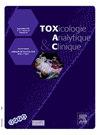LC-DAD:一种过去用来鉴定新型精神活性物质异构体的工具。氯甲卡西酮的应用
IF 1.8
Q4 TOXICOLOGY
引用次数: 0
摘要
目的正式鉴定氯甲卡西酮(x-CMC)的异构体。方法使用开曼商业文库,对一名在家死亡的男子的外周血进行一般毒理学未知筛选,气相色谱(GC)联用质谱(MS)发现x-CMC。为了正式鉴定同分异构体,获得了3-CMC和4-CMC的商业标准,并将其整合到自制的谱库(质量和紫外)中,使用筛选方法:气相色谱-质谱(乙酰化后)和液相色谱(LC)耦合二极管阵列检测(DAD/MS),以及专门用于新型精神活性物质(nps)的串联质谱方法:GC-MS/MS和LC-MS/MS。这些方法每天都在法医实验室中使用(确定死亡原因、药物滥用)。所有方法均采用极性柱。各种方法的条件先前已发表(Bottinelli, Toxac, 2017, 29,123-129;《国际法律医学》,2004,13(3):1813-1820。结果无论采用何种质谱方法,无论化合物是否乙酰化(GC), 3-CMC与4-CMC的谱线一致。GC-MS选择的特异m/z离子分别为111、139和239。对于GC-MS/MS,转变为138.9 >;110.9, 138.9 >;75.0和112.9 >;75.0, LC-MS/MS 197.9 >;145.0和197.9 >;180.0. 在测试的色谱条件下,使用GC-MS和GC-MS/MS观察到两种异构体的保留时间(RT)相同,使它们完全无法区分,尽管进行了许多温度梯度测试。LC-MS/MS上,3-CMC和4-CMC的rt分别为3.73 min和3.52 min。在LC-DAD/MS上,3-CMC (6.32 min)和4-CMC (6.54 min)的吸收光谱也能很好地区分。3-CMC的吸光度最大值分别为210和250 nm, 4-CMC的吸光度最大值分别为197和262 nm。关于本文描述的死后病例的异构体鉴定,3-CMC通过LC-DAD/MS正式鉴定,然后通过LC-MS/MS在外周血中定量(33.7 ng/mL)。结论在某些情况下,NPS异构体难以区分。一般认为,在给定的分析条件下,结构相似的化合物会发生相似的反应。因此,最初怀疑x-CMC异构体的行为与x-MMC异构体相同:即在GC上可被RT区分,而在LC-MS/MS上不可区分。这些结构的不同之处在于氯原子(CMC)取代了甲基(MMC)。在LC上,氯基允许与固定相额外的相互作用,从而促进异构体的分离。在GC上,氯基团的位置对同分异构体分离的影响较小,因为氯基团的摩尔质量比甲基高。在没有商业标准的情况下,LC-DAD/MS方法可以通过紫外光谱正式区分CMC异构体,正如之前对MMC异构体的证明(Bottinelli, Toxac, 2017,29, 123-129)。在毒理学未知筛选的一线分析中,LC-DAD/MS可以立即区分所分析的病例。二级定量可采用特异的LC-MS/MS方法,灵敏度高,定量准确,重复性好。2023年,实验室发现6例3-CMC病例,4-CMC无病例,均为化学性。本文章由计算机程序翻译,如有差异,请以英文原文为准。
LC-DAD: A tool from the past to identify isomers of new psychoactives substances. Application to chloromethcathinones
Aim
To formally identify the isomers of chloromethcathinone (x-CMC).
Method
General toxicological unknown screening performed on peripheral blood of a man found dead at home in a context of chemsex revealed x-CMC on gas chromatography (GC) coupled with mass spectrometry (MS) using the Cayman commercial library. To formally identify the isomer, commercial standards of 3-CMC and 4-CMC were obtained and integrated in homemade spectrum libraries (mass and UV) by analyzing them using screening methods: GC-MS (after acetylation) and liquid chromatography (LC) coupled to diode array detection incremented to a mass spectrometer (DAD/MS), plus targeted methods dedicated to new psychoactive substances (NPSs) by tandem mass spectrometry: GC-MS/MS and LC-MS/MS. These methods are in daily use in laboratories in forensic contexts (determination of cause of death, drug abuse). Apolar columns were used for all methods. The conditions of the various methods have been previously published (Bottinelli, Toxac, 2017,29,123–129; Epain, Int Legal Med, 2024, 138, 1813–1820).
Results
Whatever the MS method and whether the compound was acetylated or not (GC), an identical spectrum was observed for 3-CMC and 4-CMC. The specific m/z ions selected for GC-MS were 111, 139 and 239. For GC-MS/MS, the transitions were 138.9 > 110.9, 138.9 > 75.0 and 112.9 > 75.0, and for LC-MS/MS 197.9 > 145.0 and 197.9 > 180.0. Under the chromatographic conditions tested, an identical retention time (RT) was observed for the two isomers using GC-MS and GC-MS/MS, making them completely indistinguishable, despite many temperature gradient tests. However, the LC methods obtained distinct RTs: 3.73 min and 3.52 min for 3-CMC and 4-CMC, respectively, on LC-MS/MS. As well as being discriminated by RT, 3-CMC (6.32 min) and 4-CMC (6.54 min) were clearly distinguishable on LC-DAD/MS by their absorption spectra. Absorbance maxima were observed at wavelengths of 210 and 250 nm for 3-CMC and 197 and 262 nm for 4-CMC. Concerning isomer identification in the postmortem case described here, 3-CMC was formally identified by LC-DAD/MS and then quantified (33.7 ng/mL) in the peripheral blood by LC-MS/MS.
Conclusion
In some cases, it is difficult to distinguish NPS isomers. It is generally expected that compounds with similar structures will react similarly under given analytic conditions. Therefore, it was initially suspected that the x-CMC isomers would behave identically to the x-MMC isomers: i.e., differentiable by RT on GC and undistinguishable on LC-MS/MS. The difference in these structures lies in the presence of a chlorine atom (CMC) replacing a methyl group (MMC). On LC, a chloride group allows additional interaction with the stationary phase, and thus facilitates isomer separation. On GC, the position of a chloride group, which has a higher molar mass than a methyl group, has less influence on isomer separation. In the absence of commercial standards, the LC-DAD/MS method alone made it possible to formally distinguish CMC isomers by their UV spectrum, as previously demonstrated for MMC isomers (Bottinelli, Toxac, 2017, 29, 123–129). In first-line analysis in toxicological unknown screening, LC-DAD/MS allowed immediate distinction in the cases analyzed. Quantification could be carried out secondarily using a specific LC-MS/MS method with greater sensitivity and accurate reproducible quantification. In 2023, six cases of 3-CMC, and no cases of 4-CMC, were identified in the laboratory, all in contexts of chemsex.
求助全文
通过发布文献求助,成功后即可免费获取论文全文。
去求助

 求助内容:
求助内容: 应助结果提醒方式:
应助结果提醒方式:


